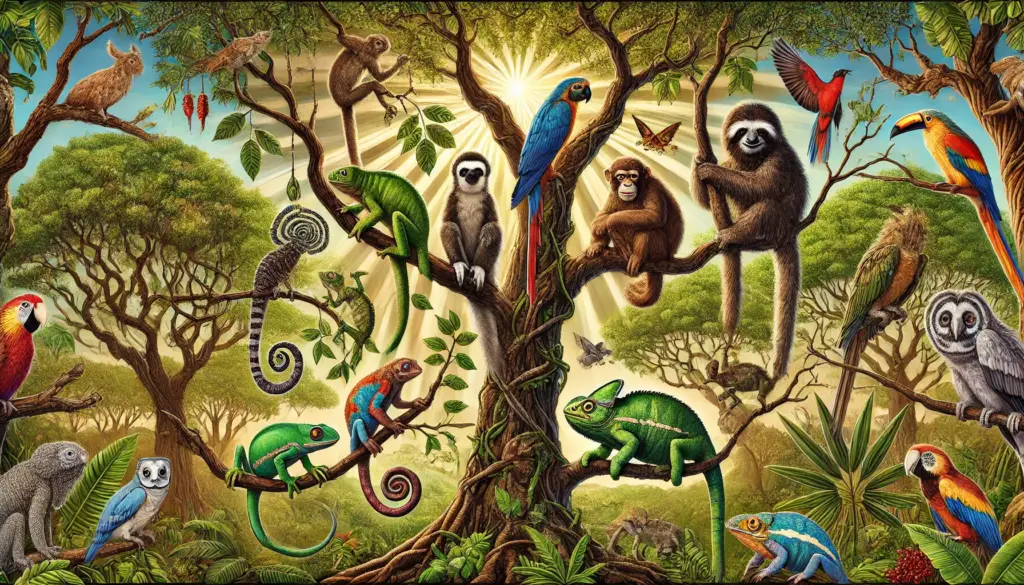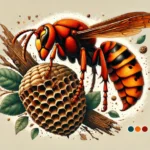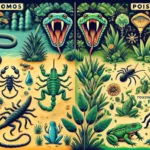Trees offer an incredible environment for a variety of animals, providing them with food, shelter, and protection from predators. Many species have adapted to life in the trees, developing specialized behaviors and features to navigate the heights. These animals, known as arboreal animals, have mastered the art of living among the branches. Here are 10 amazing animals that live in trees, showcasing their unique adaptations and habits.
1. Sloth
One of the most famous tree-dwellers is the sloth. These slow-moving mammals are found in the rainforests of Central and South America, where they spend most of their lives hanging upside down from tree branches. Sloths are incredibly well-adapted to arboreal life, with long claws that allow them to grip branches effortlessly. They are known for their lethargic pace, moving slowly to conserve energy and avoid detection by predators.
Sloths feed on leaves, flowers, and fruits found high in the canopy. Their slow metabolism allows them to survive on a low-calorie diet. Despite their sluggish reputation, sloths are excellent swimmers and can move quickly in water when needed.
A Unique Adaptation: Slow Metabolism
Sloths have a low metabolic rate, which helps them conserve energy. This slow metabolism is perfectly suited to their treetop lifestyle, allowing them to go for days without moving while they digest their food.
2. Spider Monkey
Spider monkeys are among the most agile tree-dwellers, using their long limbs and prehensile tails to swing effortlessly through the forest canopy. Native to the rainforests of Central and South America, spider monkeys are known for their incredible ability to navigate trees, using their tails like an extra hand to grasp branches and stabilize themselves as they move.
These primates are social animals, often traveling in groups as they forage for fruits, seeds, and leaves. Their long arms and tails enable them to cover large distances in search of food, and they are capable of impressive leaps between trees.
Prehensile Tail: A Tool for Survival
The prehensile tail is one of the most remarkable features of the spider monkey, acting as an extra limb. The tail is strong and flexible, allowing the monkey to hang, balance, and even carry objects while foraging.
3. Chameleon
The chameleon is a master of camouflage, blending seamlessly into its treetop surroundings. These reptiles are known for their ability to change color, which helps them regulate body temperature and communicate with other chameleons. Chameleons have highly specialized feet with two sets of fused toes, allowing them to grip branches securely as they climb.
Chameleons have a unique hunting strategy—they use their long, sticky tongues to catch insects from a distance. Their eyes can move independently, giving them a full 360-degree view of their surroundings as they wait patiently for prey.
Color-Changing Abilities
Chameleons can change their color to reflect their mood, temperature, or environmental conditions. This adaptation is crucial for staying hidden from predators and regulating their body temperature while living high in the trees.
4. Koala
The koala is one of Australia’s most iconic tree-dwelling animals. These marsupials spend most of their lives perched in eucalyptus trees, feeding on the leaves. Koalas have specialized claws and opposable digits, which allow them to climb and grip branches with ease. Their diet of eucalyptus leaves is low in nutrients, so koalas conserve energy by sleeping for up to 20 hours a day.
Female koalas carry their young, known as joeys, in a pouch until they are ready to explore the trees on their own. While they may look cuddly, koalas are territorial and spend most of their time alone, except during mating season.
Specialized Diet
Koalas have evolved to digest eucalyptus leaves, which are toxic to most animals. Their slow metabolic rate allows them to extract the maximum amount of nutrients from this fibrous diet, making them perfectly suited to life in the eucalyptus forests.
5. Tree Frog
Tree frogs are small amphibians found in tropical and temperate forests around the world. As their name suggests, these frogs are well-adapted to life in the trees. Tree frogs have sticky pads on their toes, which allow them to climb and cling to leaves and branches. They are often brightly colored, with hues of green, yellow, or blue, which help them blend in with their surroundings.
Most tree frogs are nocturnal, coming out at night to feed on insects. Their excellent climbing abilities and camouflaged appearance help them avoid predators, while their loud calls are used to attract mates.
Sticky Toe Pads
Tree frogs have specialized toe pads that produce a sticky secretion, allowing them to cling to smooth surfaces like leaves and branches. This adaptation is essential for navigating the treetops and escaping predators.
6. Orangutan
Orangutans are the largest tree-dwelling animals in the world. Found in the rainforests of Borneo and Sumatra, these great apes spend most of their lives in the forest canopy, moving slowly between branches as they search for food. Orangutans have long, powerful arms that allow them to swing from tree to tree, and their grasping feet are as dexterous as their hands.
Orangutans are solitary animals, and they build nests high in the trees to sleep at night. Their diet consists mainly of fruits, leaves, and insects. Sadly, orangutans are critically endangered due to habitat loss and deforestation.
Arboreal Nest Builders
Orangutans build sleeping nests in the trees every night, using branches and leaves to create a comfortable and secure resting place. This habit allows them to stay high above the forest floor, away from predators.
7. Squirrel
Squirrels are agile and energetic animals commonly found in forests and urban areas around the world. These small rodents are expert climbers, using their sharp claws and bushy tails to navigate tree branches with ease. Squirrels build nests, known as dreys, in the forks of trees, where they raise their young and store food.
Squirrels are known for their habit of hoarding nuts and seeds, burying them in the ground or storing them in tree cavities. Their ability to remember the locations of their food stores helps them survive through the winter when food is scarce.
Food Hoarding
Squirrels have an excellent memory, allowing them to locate their food caches even after weeks or months. This food-hoarding behavior ensures they have enough to eat during the colder months when other food sources are unavailable.
8. Gibbon
Gibbons are small apes known for their incredible ability to move through the treetops using a form of locomotion called brachiation, or swinging from branch to branch. Gibbons are found in the tropical forests of Southeast Asia, where they live in small family groups.
With their long arms and strong hands, gibbons can swing at high speeds through the forest canopy, covering large distances in search of food. They feed primarily on fruits, leaves, and insects, and their loud calls are used to communicate with other members of their species.
Master of Brachiation
Gibbons are among the fastest and most agile tree-dwellers, using their long arms to swing effortlessly through the forest. Their ability to brachiate allows them to move quickly and avoid predators on the ground.
9. Iguana
The iguana is a large, herbivorous lizard that lives in the trees of Central and South America. Green iguanas are particularly well-known for their arboreal lifestyle, spending much of their time basking in the sun on tree branches. They have long tails and sharp claws, which they use to climb and defend themselves from predators.
Iguanas feed on leaves, flowers, and fruits, and they are excellent swimmers, often diving into water to escape danger. Their ability to blend into the green foliage makes them difficult to spot in the wild.
Sharp Claws for Climbing
Iguanas have long, sharp claws that allow them to climb trees with ease. These claws are essential for navigating their forest environment and escaping from predators.
10. Lemur
Lemurs are primates native to the island of Madagascar, where they live in the forest canopy. There are many species of lemurs, ranging from the tiny mouse lemur to the larger ring-tailed lemur. Lemurs are social animals that live in groups and are known for their agility and ability to leap between trees.
Lemurs feed on fruits, leaves, and insects, and they play an important role in the ecosystem as seed dispersers. Their large eyes and strong hind legs are well-suited for life in the trees, and they spend most of their time foraging and interacting with other members of their group.
Arboreal Acrobats
Lemurs are skilled at leaping between trees, using their strong hind legs to propel themselves from branch to branch. Their agility allows them to navigate the treetops in search of food and avoid predators on the ground.
Conclusion
The world of arboreal animals is diverse and fascinating, with each species developing unique adaptations to thrive in their tree-top environments. From the slow-moving sloth to the agile gibbon, these animals have mastered life in the trees, showcasing the incredible variety of life on our planet. Whether it’s for food, shelter, or protection, the ability to live in trees offers numerous advantages that have helped these species survive and flourish.
FAQ
Why do animals live in trees?
Animals live in trees to find food, shelter, and protection from predators. The height and cover provided by trees offer safety and a steady source of food, especially for species that feed on leaves, fruits, or insects.
What adaptations help animals live in trees?
Arboreal animals often have specialized adaptations such as strong claws, prehensile tails, sticky toe pads, and long limbs that help them climb, balance, and navigate tree branches. These adaptations enable them to move efficiently in the tree canopy and escape predators.
How do sloths survive in trees?
Sloths have long claws that allow them to hang from branches and move slowly to conserve energy. Their slow movement helps them avoid detection by predators, and their specialized diet of leaves is abundant in their tree-top habitat.
Are all monkeys tree-dwellers?
While many monkeys live in trees, not all species are exclusively arboreal. Some monkeys, such as baboons, spend more time on the ground, but most species, like spider monkeys and gibbons, are adapted to life in the trees.
How do tree frogs climb?
Tree frogs have specialized toe pads that secrete a sticky substance, allowing them to grip smooth surfaces like leaves and tree trunks. This adaptation helps them climb and remain secure in the trees.
What is brachiation?
Brachiation is a form of movement used by some primates, such as gibbons, where they swing from branch to branch using their arms. This method of locomotion allows them to move quickly and efficiently through the forest canopy.


